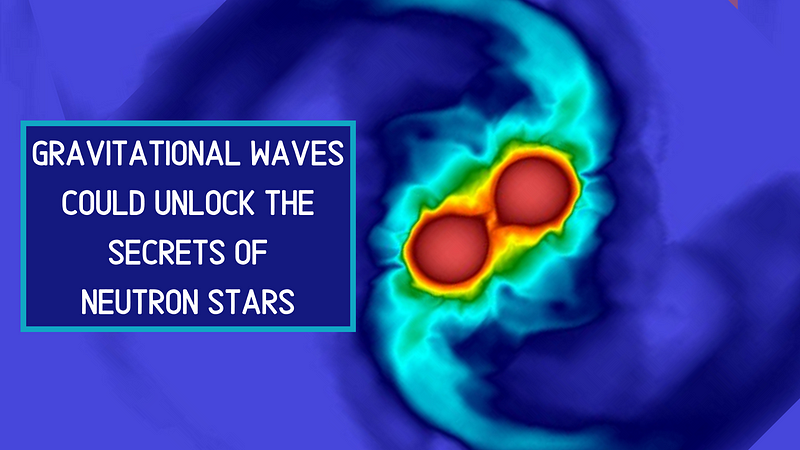Unlocking Neutron Star Mysteries Through Gravitational Waves
Written on
Chapter 1: The Enigma of Neutron Stars
Neutron stars, which contain the second densest matter in the universe, stand as some of the most enigmatic entities in the cosmos. Recent advancements in gravitational wave modeling may hold the key to unraveling their mysteries.

These stellar remnants, born from the explosive deaths of massive stars, are not only incredibly dense but also pose numerous unanswered questions. A primary inquiry revolves around their maximum size. While we know that neutron degeneracy pressure prevents their collapse into black holes, the precise threshold at which this occurs remains uncertain.
Traditional astronomy, heavily reliant on electromagnetic observations, has limitations when it comes to understanding neutron stars. Moreover, laboratory experiments on Earth have struggled to replicate the extreme conditions present at their cores, leaving many questions unanswered.
However, gravitational waves—ripples in spacetime first predicted by Einstein's general relativity—might bridge this knowledge gap.
Section 1.1: New Gravitational Wave Model
Researchers at the University of Birmingham have developed a novel gravitational wave model that enables astronomers to probe the internal structure of neutron stars. This approach aims to ascertain their properties, composition, and structure.
By determining these properties, scientists can formulate an equation of state (EoS) for neutron stars, establishing the relationship between density and pressure. This EoS is crucial for understanding the mass-radius relationship of neutron stars and how they respond to gravitational forces.
Section 1.2: Measuring Oscillations
Dr. Geraint Pratten, the study's lead author, explains, "Our paper utilizes a model created by my co-authors to constrain the fundamental oscillation modes of neutron stars solely from gravitational wave data." The model suggests that the oscillations of neutron stars can be directly measured through gravitational wave signals, which are influenced by tidal forces that deform the stars.
“Neutron stars exhibit characteristic oscillations that reflect their internal structure and EoS. By isolating these oscillations, we gain a sensitive probe into their core,” Pratten adds. This methodology resembles helioseismology, which studies the Sun's internal structure through its oscillations, and seismic studies of Earth’s core through earthquakes.
Chapter 2: The Synergy of Neutron Stars and Gravitational Waves
The unique tidal forces acting on neutron stars within binary systems result in gravitational wave signatures that the team aims to analyze. As two neutron stars orbit each other, their shapes are distorted by gravitational interactions, leaving a distinctive imprint in the gravitational wave signal.
It is noteworthy that gravitational waves were first detected from a binary black hole merger in 2015, and two years later, the event GW170817—a merger of neutron stars—provided a pivotal moment in gravitational wave astronomy.
By applying their model to GW170817, researchers successfully extracted information about the neutron star's oscillations from the gravitational wave measurements, marking a significant milestone in the field.
Section 2.1: Insights from GW170817
The analysis of GW170817 allowed the team to constrain neutron star radii to within 4 km and provided the first direct measurements of tidal deformability, which relates to the EoS. This discovery underscores the potential of gravitational wave observations to complement traditional astronomical methods.
Dr. Patricia Schmidt, a co-lead author, emphasizes the importance of this research: “Three years post-detection, we are still uncovering valuable information encoded in gravitational wave signals and refining our extraction techniques.”
As the field progresses, new detectors like the Laser Interferometer Space Antenna (LISA)—the first space-based gravitational wave observatory—are set to enhance our capabilities for studying these cosmic phenomena.
Section 2.2: The Future of Gravitational Wave Astronomy
Pratten notes, "Our initial study demonstrated that future gravitational wave detectors could accurately measure neutron star oscillations." The potential to gather unprecedented data from gravitational waves represents a significant leap forward in our understanding of the universe.
As researchers delve deeper into gravitational wave data, they lay the groundwork for future explorations of neutron stars and black holes, opening avenues for discoveries that could redefine our comprehension of astrophysics.
Special thanks to Dr. Geraint Pratten for his contributions to this research.
Original research: Pratten, G., Schmidt, P., Hinderer, T. (2020). ‘Gravitational-wave asteroseismology with fundamental modes from compact binary inspirals,’ Nature Communications.